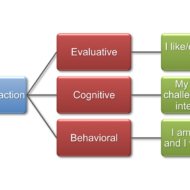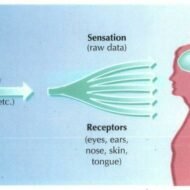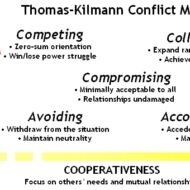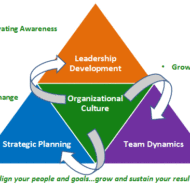Currently Browsing: Principles of Management
Posted by Managementguru in Business Management, Human Resource, Organisational behaviour, Principles of Management, Training & Development
on Apr 5th, 2014 | 0 comments

Attitude and Job Satisfaction What is attitude? Attitudes are evaluative statements or judgments concerning objects, people or events –Stephen Robbin. They also represent an ‘affective orientation towards an object.’ It simply means what one feels and thinks about something. Elements of attitude: Cognitive components – opinion or belief Affective components – emotion or feeling Behavioral components – intention to behave The interaction of these three components determines the way in which an individual develops an attitude towards something. Sources: Society Friends Teachers Family Members It also forms on the basis of the level of admiration we have over an object or persons. People also try to imitate others and attitudes are gradually formed on that basis also. In some attitudes formed are less stable, in some they even dominate the whole life. Types: Organizational behavior uses the concept of attitudes in relation to nature of the job and its influence on the performance of the persons. Accordingly, Job Satisfaction Job Involvement and Organizational Commitment, are the three kinds of attitude a person could have with respect his / her job or organization. Job Satisfaction: In “Job Satisfaction “, Stephen P. Robbins writes about five factors which make a person satisfied with his or her job. These factors are Mentally challenging work Equitable rewards Supportive working conditions Supportive colleagues and Personality-job fit. Cranny, Smith and Stone define job satisfaction as employees’ emotional state concerning the job, considering what they anticipated and what they actually got out of it. In fact, an employee with low expectations can be more satisfied with a certain job than someone who has high expectations. If one’s expectations are met or surpassed by the job, then one is happy and satisfied with the job. Job Involvement: Job involvement has been defined as an individual’s psychological identification or commitment to his / her job. As such individuals who display high involvement in their jobs consider their work to be a very important part of their lives- In other words for highly involved individuals performing well on the job is important for their self esteem. Organizational Commitment: Three important elements of a committed individual would be Identification with the organization’s goals and/or mission Long-term membership in the organization and intention to remain with the organization, often termed loyalty High levels of extra role behavior- behavior beyond required performance- Often denoted to as citizenship behavior or pro-social behavior. Cognitive Dissonance Theory: Leon Festinger developed this theory which explains the relationship between attitude and behavior. It refers to”any incompatibility that an individual might perceive between two or more of his or her attitudes, or between his or her behavior and attitudes.” Attitude Surveys: This is a tool that helps to collect information about the levels of attitude among the people. In most companies these kinds of surveys are conducted with the help of different rating scales like Likert scale offering five or seven alternative choices for each of the statement developed for attitude measurement. Summary: Research conducted on attitude and job satisfaction in Indian workers has made clear certain points as given below: Attitude is positively correlated with efficiency Absenteeism will bring down satisfaction levels Unions, negatively affect the employee attitude and job satisfaction Attitude researches and surveys will improve...

Posted by Managementguru in Business Management, Human Resource, Organisational behaviour, Principles of Management
on Apr 2nd, 2014 | 0 comments

Perception in OB (Organizational Behavior) Context – The Sub-Processes Involved What is Perception? A cognitive information processing process that enables us to interpret and understand our environment. According to Stephen P Robbins, Perception is a process by which individuals organize and interpret their sensory impressions in order to give meaning to their environment. The term originated from a Latin word ‘percepio’ meaning receiving, collecting, action of taking possession, apprehension with the mind or senses. The process by which people translate sensory impressions into a coherent and unified view of the world around them. Difference between perception and sensation: There is a great deal of misunderstanding between sensation and perception. Perception is broader in sense than sensation and it is more complex. The process of perception involves an interaction of selection, organization and interpretation. Though it largely depends upon the senses to receive raw data or information to be translated. For example, when you view an object at a distance and slowly turn your eyes to the other side of the object, you feel as if the object is moving, but you very well know that is not the case – the object is stationary. The perceptual process overcomes the sensual process. The perceptual process adds to and subtracts from the “real” sensory world. In an organizational context this can be best explained as follows: 1. A sub-ordinate’s answer to a question is based on what he heard the boss say, not on what the boss actually said. 2. The same worker may be viewed by one supervisor as a very good worker and by another supervisor as very poor worker. Game of your Mind – What is Perception? ALL ABOUT PERCEPTIONS! This video tell you all about perception, with excellent examples. Which will help you understand game of our mind. -What are perceptions? -How does one perceive? -What are … SOBC MODEL OF PERCEPTION: S-Stimulus, O-Organizing and Interpreting Data, B-Behavior, C-Consequences The S-O-B-C Model best explains the sub-process involved in perception. The process starts only when the person or individual is confronted with sensual stimulation which then leads to internal cognitive processes of registration, interpretation and feedback. I’m reminded of this saying by Moorhead & Griffin “If everyone perceived everything the same way, things would be a lot simpler”. The very difference in the manner in which people perceive and react to the same matter is what makes life more interesting but alas, complicating too. A supervisor’s raised eye-brow or change in voice modulation is a definite warning signal which never goes un-noticed by the sub-ordinates as it affects the psychological process of a person directly. General Perceptional Errors: Fundamental attribution error: The tendency to underestimate the influence of external factors and overestimate the influence of internal factors when making judgments about the behaviour of others Self-serving bias: The inclination to ascribe one’s own successes to internal factors and blame one’s own failures on external factors Selective perception: The tendency to selectively interpret what is seen based on one’s interests, background, experience and attitudes Projection: The tendency to attribute one’s own characteristics to other people Stereotyping: The tendency to evaluate someone on the basis of the perception of a group to which that person belongs Halo effect: The tendency to draw a general impression about an individual based on a single characteristic Perception is how you look at things. Attitude is the way that you act towards something. Although perception can determine your attitude, you do not have to let...

Posted by Managementguru in Business Management, Change management, Human Resource, Organisational behaviour, Principles of Management
on Mar 31st, 2014 | 0 comments

India often looks at Japanese or American models to comprehend the concepts of management. In reality, Indian scriptures can be considered as treasuries of management. The Bhagavat Gita, the Vedas and the Epics highlight the true spirit of working together and the need for de-stressing the self for enhanced performance levels. The idea of NISHKAMYAM (to perform one’s own work without expecting a result) is truly said to be the highest ideology preached by Lord Krishna. What Induces Stress? A dynamic condition in which an individual is presented with an opportunity or confronted with a demand, related to what she or he desires and for which the outcome is uncertain but important, can be called a stressful situation. The consequences of stress in an organizational set up express themselves in the form of physiological, psychological or behavioral symptoms, which are harmful to the individuals who experience high levels of stress. Symptoms of stress: AnxietyDepressionIncreased job dissatisfactionAbsenteeismDecline in productivityRapid turn overHigh blood pressureHeart diseasesHead aches Stress Can be Motivating: While long term stress is harmful to the individual and organization as well, it is said that short term stress serves the purpose of task accomplishment by individuals or groups, within the stipulated time. It serves as a motivation factor rather than a causative agent of frustration. It has been proved by scientists and medical researchers that stress has a direct effect on the metabolism of a person, that causes increase in heart and breathing rates, increase in blood pressure, thus inducing heart attacks. Equally important are the behavioral and attitudinal changes that are created by stress, which cannot be overlooked. Job Satisfaction: Psychological symptoms arise due to job-related dissatisfaction, boredom, work pressure, irritability and procrastination. Sometimes forceful involvement may also lead to decreased job satisfaction. The job to be carried out can be finished at the particular time if the individual is able to give one’s best shot. But when it is performed under stress, they complete the job with dissatisfaction. When the incumbent is asked to perform a task that lacks clarity, naturally ambiguity arises in his mind followed by anxiety. Behavioral Symptoms of Stress Changes in productivity levels, absence, and rapid staff turnover are stress symptoms of behavioral nature. It might be expressed even in the form of increased smoking, consumption of alcohol etc., Say for instance, in production department, when there is a need to supply a product in a very limited time, the workers may be active initially, but the performance slows down when they get totally tired or dissatisfied with the work. Again the demand by the superior adds additional stress that reaches unmanageable levels. Similarly, people taking care of administration, banking, marketing and other office related works fall a prey to stress. How to manage stress? From an organization view point, it is believed that a limited amount of stress may work wonders in terms of performance, with stress acting as a “positive stimulus”. But even low levels of stress are likely to be perceived as undesirable from an individual’s stand point. How could be the notion of management and individuals be different on the acceptable levels of stress? It does not solve the purpose. Individuals have to understand that, they have to live up to the expectations of the management in order to enhance their credit ratings, in terms of promotion and pay. They have to understand that challenges are to be perceived as opportunities to prove their mettle. Self and situational analysis, work analysis, time management and physical well- being are some techniques that practically solve problems of stress. “De-stressing the Self” Techniques for Employees Organisations can reduce stress of the employees...

Posted by Managementguru in Human Resource, Organisational behaviour, Principles of Management, Strategy, Training & Development
on Mar 31st, 2014 | 0 comments

Conflict is a Part of Organizational Life Managers need to be alert to the presence of conflicts. Their focus should be oriented towards the goals to be accomplished. If there is a conflict, they should aim to resolve it smoothly by not over-reacting to the situation. They should take the help of persons who can best settle the issue, be ready to bargain and not issue orders. Their concentration should be on the problem and not on persons. True to the saying – Am I not destroying my enemies when I make friends of them?- President Abraham Lincoln Conflicts are Functional and Healthy: Conflicts in organisations are generally considered to be dysfunctional. On the contrary, many top executives of big companies view conflicts, as a means, to sufficiently analyse a problem and postpone decision making until all critical aspects of an issue are evaluated properly. Conflicts may occur within the individual, between individuals, between the individual and the group or between groups. There are many potential sources of conflict in today’s corporate organisations. The complex inter personal relationships and high degree of interdependence causes friction. Difference of Opinion: When many people must work together, conflict is inevitable, as it is human nature to clash and complain. Conflict is the personal divergence of interests between groups or individuals. The need to share scarce resources, difference in goals between organisational units, difference in values, attitudes and perception, ambiguously defined work responsibilities are some of the major sources of conflict. Functional Conflicts: Functional conflicts support the goals of a group, improve its performance and are constructive in nature. Dysfunctional conflicts hinder the performance of a group and are destructive in nature. It has not been precisely defined, as to what criterion demarcates functional from the dysfunctional. It is only the group’s performance and the delivered result or outcome that determines the nature of the conflict. Conflicts, irrespective of their type can bring these benefits to the firm: Bring hidden issues to the surface. Encourage creativity and innovation. Improves communication and make changes more acceptable. Increases group cohesion. Strategies to Resolve Conflicts: So, what kind of strategy do you think best suits in resolving conflicts? Avoiding or smoothing conflicts may be a temporary measure, only to bounce back in full force. Forcing might create undesirable consequences. The only option left is to confront the situation, face-to-face meeting of the conflicting parties for the purpose of identifying the problem and resolving it through an open discussion. Make Structural Changes to Lessen Conflicts: By making structural changes, conflicts can be managed. The objectives of a group are modified and then integrated to suit the purpose. Also changes in the structure of the organization, that is, clarification of authority-responsibility relationship, improving the working atmosphere, ambience and work locations help in resolving conflicts. Proper Communication: Lack of proper communication, ego clashes between the people in line and staff positions, a superior’s autocratic leadership style, differing educational backgrounds, lack of co-ordination between inter-departments are all rich sources of conflict. These can be resolved with the right kind of attitudinal approach and an open mind from the management’s...

Posted by Managementguru in Entrepreneurship, Human Resource, Organisational behaviour, Principles of Management, Training & Development
on Mar 31st, 2014 | 0 comments

Defining Organizational Culture Business is an integral part of the society; and it influences other elements of the social system, which in turn affect business. The entire sphere of business activities are influenced by the social structure and culture of a society. The social system is influenced by the way the business functions, innovations, transmission and diffusion of information and new ideas etc. Business activities have greatly influenced social attitudes, values, outlooks, customs and traits. However, it is very difficult and, in some cases, almost impossible to change many elements of the social environment in the short run. Hence, a business may have to anticipate and adapt to these uncontrollable external environments. Socio-cultural environment refers to the influence exercised by certain social factors, which are “beyond the company’s gate“. This includes attitude of people towards: Work Wealth Knowledge Family Marriage Religion Education Ethics and social responsibility of business. Belief System Influencing the Action: Culture is something that is evolved in a society over a long period and it represents the unified belief system of a large group of people. An organization can be distinguished from another by way of its culture, since organizational culture is unique in its perspective and methodology. When people from different social backgrounds are made to work under the same roof, a corporate organization acquires a distinct culture. Culture conveys a sense of identity for the organization. It facilitates the generation of commitment to do something noble than one’s own self-interest. Cultural Differences: As business go international, the need for understanding and appreciating cultural differences across countries is essential. Any move from one country to another will create a certain amount of confusion, disorientation and emotional upheaval. Especially, people form Asian countries that migrate to the west are subjected to what is called a “culture shock”, in terms of attitude, working style, language, way of life, dress codes and negotiating styles. Freshers may adapt to these changes quickly, since they are natural and easy to be trained. The problem arises with individuals who had been working under a totally different cultural setup from that of the new cultural environment; they will have to undergo the process of ‘unlearning‘, which is more like swapping old ideas for new ideas. This change process is what both the employees and the management find challenging; but ultimately what needs to be done has to be done. Culture Shock: Multi national and Trans national companies, which have business establishments in different parts of the world, must be prepared to cope with the culture shock. Since huge investments go into their projects, they have to think and analyze about the cultural and social aspects that have a definite impact on the working of organisations. For example, the work attitude of employees in the west might lay emphasis on services and results, oriented towards self-improvement; while that of the Asian counterparts may be patience and sacrifice rooted in emotions and loyalty. Business can be considered as a large social network serving to satisfy economic and social interests; culture acts as the social glue that helps hold the organization together by providing appropriate standards for the behavior of organization members. Slogans of Some Reputed Organizations in the Industry: Nokia: Connecting people Jet Airways: The joy of flying Reliance Industries: Growth is life Citibank: Your citi never sleeps The above cited examples give you a fair idea about what a particular company stands for. The orientation of these companies, expressed in the form of SLOGANS contributed to the successful conduct of their...










